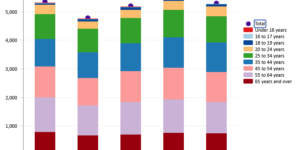When El Niño strikes, the band of warm ocean water spanning from South America to Asia triggers global weather changes, resulting in damaging floods, crop-killing droughts, plummeting fish population and an uptick in tropical diseases.
The financial toll of the recurring climate pattern can persist for several years after the event, costing trillions in lost income worldwide, according to a newly released Dartmouth report in the journal Science. The study is one of the first to evaluate the long-term costs of El Niño and projects losses that far exceed those estimated by previous research.
El Niño is the warm phase of the El Niño-Southern Oscillation, the natural cycle of warm and cold temperatures in the tropical Pacific Ocean that includes La Niña, El Niño’s cooler counterpart. El Niño alters weather patterns worldwide. In the U.S., it typically results in wetter, warmer winters for the West Coast and a milder hurricane season on the Atlantic seaboard.
The researchers spent two years examining global economic activity in the decades following the 1982-1983 and 1997-1998 El Niño events and found a “persistent signature” of slowed economic growth more than five years later. The global economy bled $4.1 trillion and $5.7 trillion, respectively, in the half-decade after each of these events, most of it borne by the world’s poorest nations in the tropics.
The researchers project that global economic losses for the 21st century will amount to $84 trillion, as climate change potentially amplifies the frequency and strength of El Niño — even if carbon emissions are reduced. Researchers estimate the El Niño predicted for this year could hold the global economy back by as much as $3 trillion by 2029.
According to Christopher Callahan, lead author, the study addresses an ongoing debate about how quickly societies rebound from major climate events.
“We can say with certainty that societies and economies absolutely do not just take a hit and recover,” said Callahan, adding the data suggested a downturn after El Niño could last as long as 14 years, if not longer.
“In the tropics and places that experience the effects of El Niño, you get a persistent signature during which growth is delayed for at least five years,” he said. “The aggregate price tag on these events has not ever been fully quantified. You have to add up all the depressed growth moving forward, not just when the event is happening.”
The findings, according to senior author Justin Mankin, assistant professor of geography, highlight a critical and understudied factor shaping the economic toll of global warming: year-to-year variations in climate conditions. While these swings are largely independent from global warming, they can amplify or diminish its effects. Once described as the “trunk of the tree of climate variability,” El Niño is the largest and most important source of year-to-year climate variation, altering weather around the world and resonating across national economies.
When it comes to climate change, world leaders and the public rightfully focus on the unabated rise in the global average temperature, Mankin said. “But if you’re estimating the costs of global warming without considering El Niño, then you are dramatically underestimating the costs.”
“Our welfare is affected by our global economy, and our global economy is tied to the climate,” Mankin added. “When you ask how costly climate change is, you can start by asking how costly climate variation is. We’re showing here that such variation, as embodied in El Niño, is incredibly costly and stagnates growth for years, which led us to cost estimates that are orders of magnitudes larger than previous ones.”
The 1982-1983 and 1997-1998 events caused the gross domestic product of the United States to be approximately 3 percent lower in 1988 and 2003 than it would have been otherwise, according to Callahan and Mankin. But in 2003, the GDPs of coastal tropical nations such as Peru and Indonesia were lower by more than 10 percent.
“The global pattern of El Niño’s effect on the climate and on the prosperity of different countries reflects the unequal distribution of wealth and climate risk, not to mention the responsibility for climate change, worldwide,” Mankin said. “El Niño amplifies the wider inequities in climate change, disproportionately impacting the least resilient and prepared among us.”
“The duration and magnitude of the financial repercussions we uncovered suggests to me that we are maladapted to the climate we have,” he added. “Our accounting dramatically raises the cost estimate of doing nothing. We need to both mitigate climate change and invest more in El Niño prediction and adaptation because these events will only amplify the future costs of global warming.”
The 2023 El Niño is predicted to come at a time when sea-surface temperatures are at an all-time high, Callahan said. The last major El Niño occurred in 2016 and made that year the hottest in recorded history. Global warming has only intensified in the seven years since. In addition, the world is coming out of an extended La Niña and the two phases can strengthen each other. The National Oceanic and Atmospheric Administration projects the chances of El Niño setting in by late summer as higher than 80 percent.
“The deck is potentially stacked for a really big El Niño,” Callahan said. “Our results suggest that there will likely be a major economic toll that depresses economic growth in tropical countries for potentially up to a decade. The result could be trillions of dollars in productivity lost globally relative to a world without this El Niño.”
Source: Dartmouth College





















 Slideshow: Carrier Management’s 2024 Top Editor’s Picks (Unlocked)
Slideshow: Carrier Management’s 2024 Top Editor’s Picks (Unlocked)  Mixed Bag: What Trump 2.0 Tariffs, DOGE Activities Mean For Insurers
Mixed Bag: What Trump 2.0 Tariffs, DOGE Activities Mean For Insurers  Dear Elon and Vivek: Insurance Commissioners Urge DOGE to Ditch FIO
Dear Elon and Vivek: Insurance Commissioners Urge DOGE to Ditch FIO  Swiss Re’s Business Unit CEOs Share Views on Key Risk Themes of 2025
Swiss Re’s Business Unit CEOs Share Views on Key Risk Themes of 2025 




